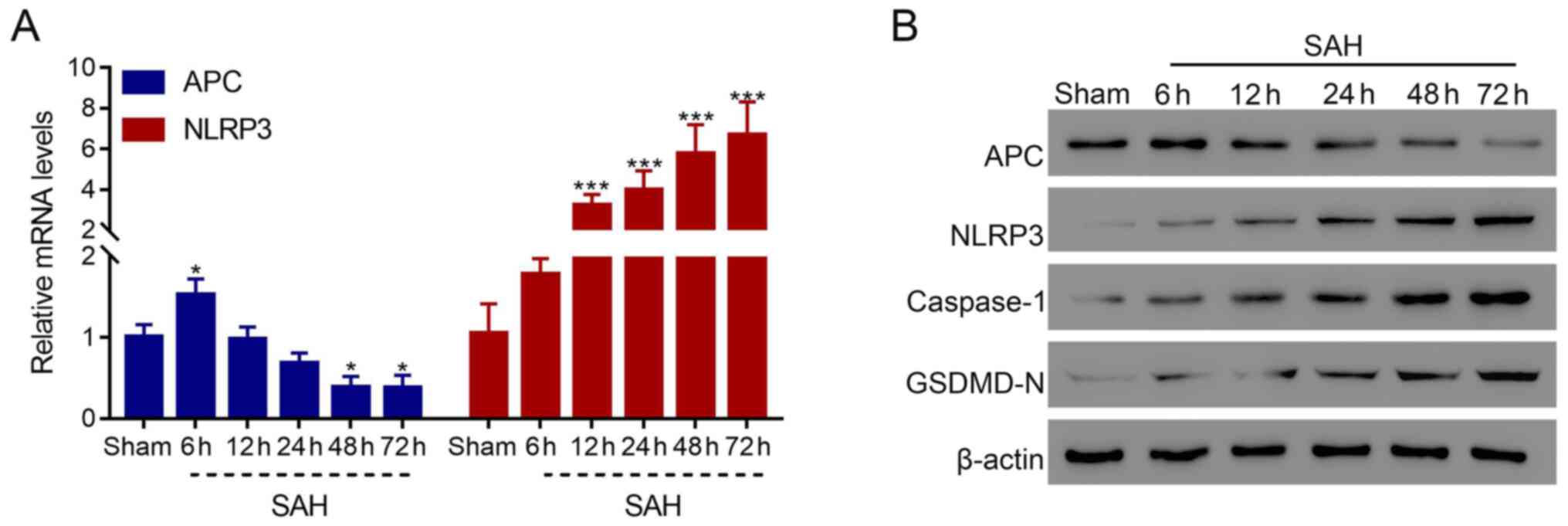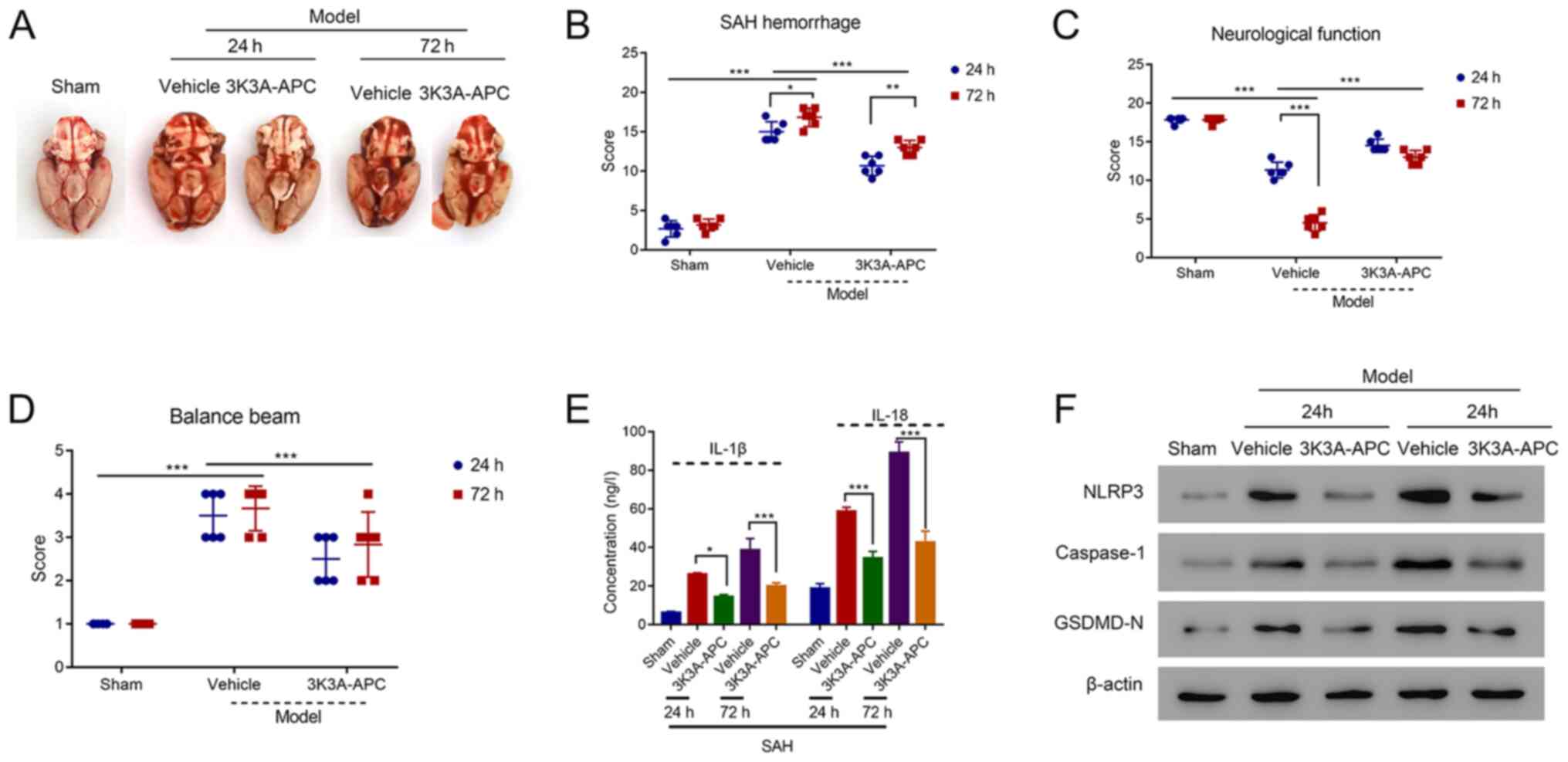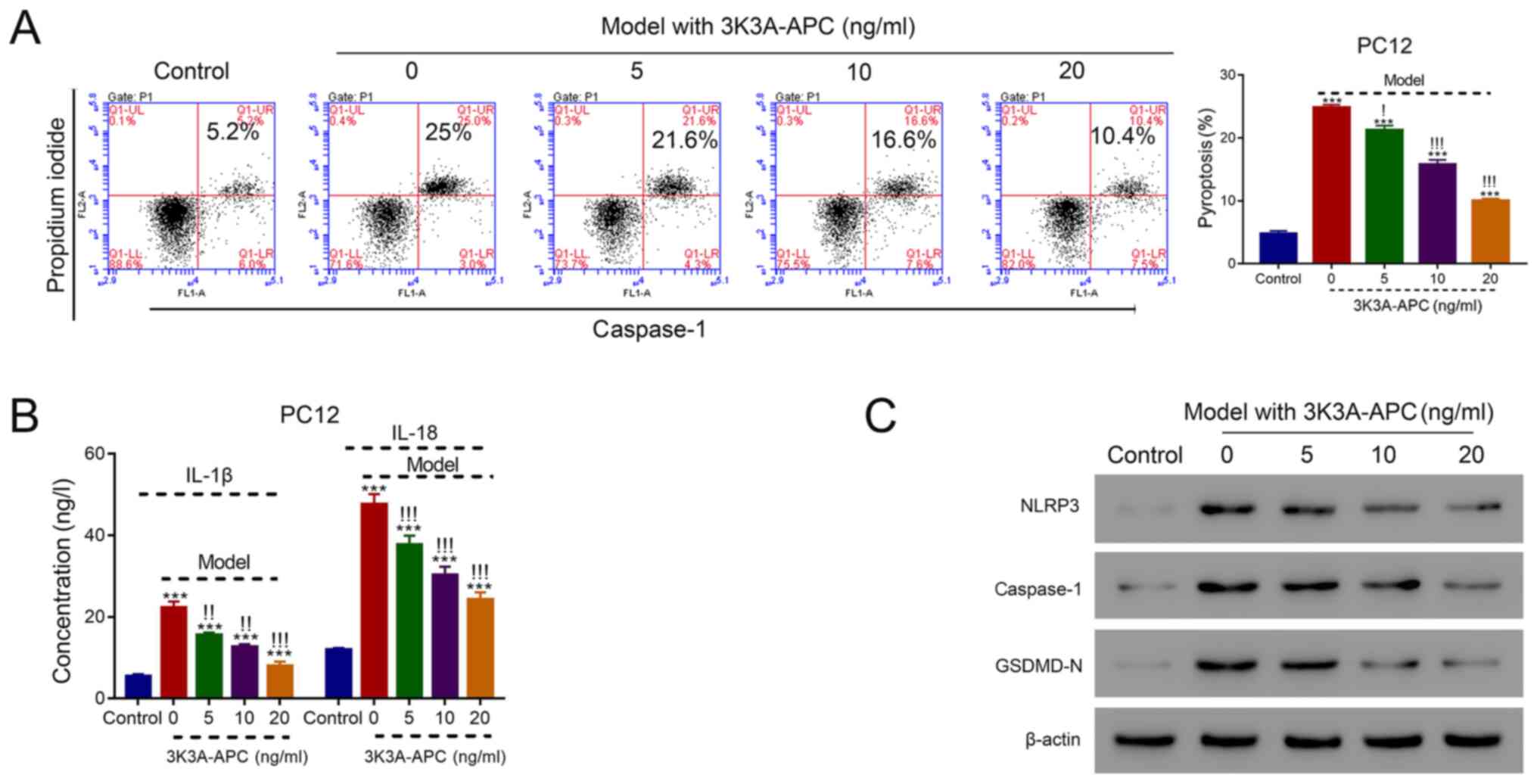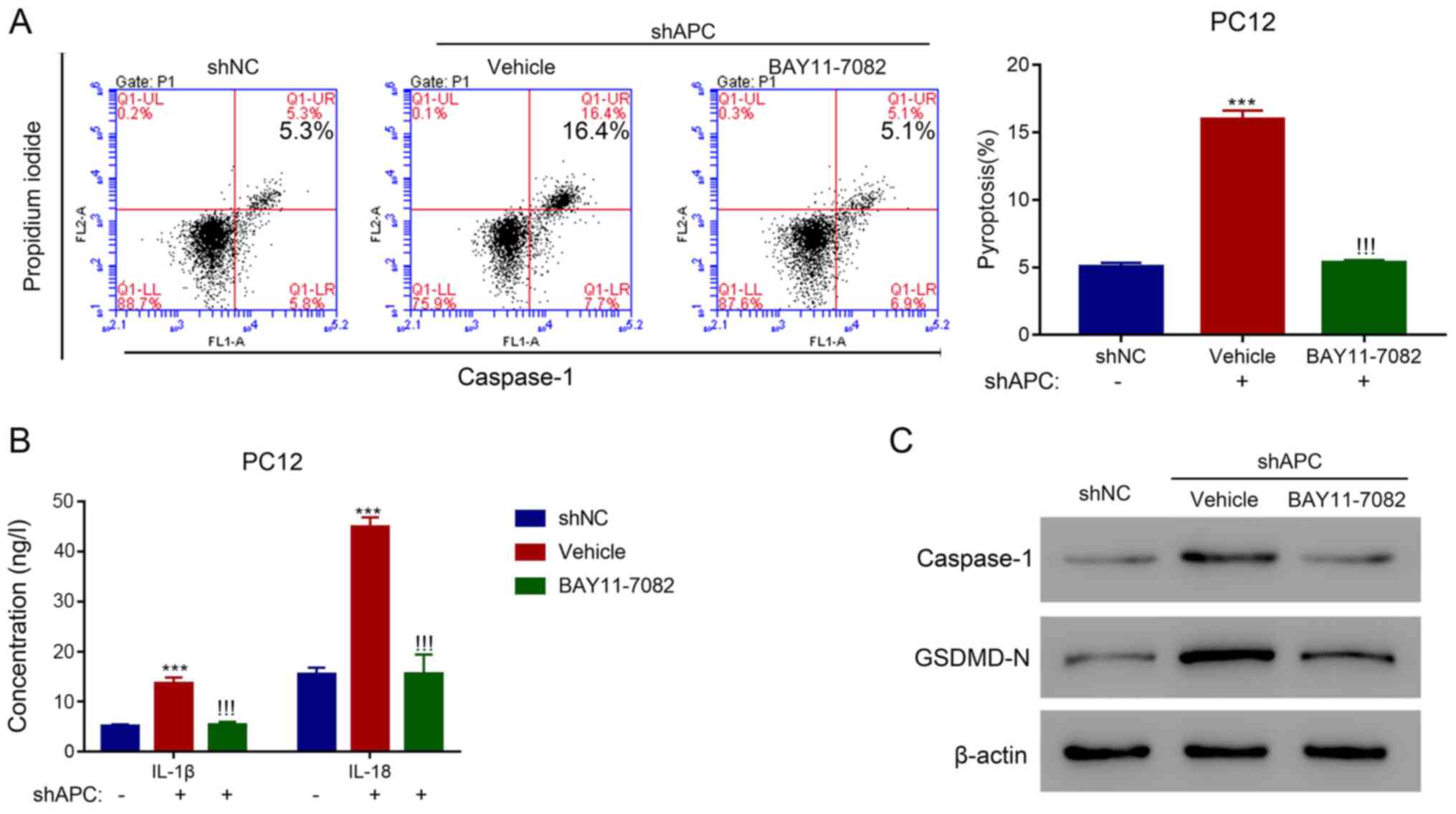|
1
|
Dupont SA, Wijdicks EF, Lanzino G and
Rabinstein AA: Aneurysmal subarachnoid hemorrhage: An overview for
the practicing neurologist. Semin Neurol. 30:545–554.
2010.PubMed/NCBI View Article : Google Scholar
|
|
2
|
Rosen DS and Macdonald RL: Subarachnoid
hemorrhage grading scales: A systematic review. Neurocrit Care.
2:110–118. 2005.PubMed/NCBI View Article : Google Scholar
|
|
3
|
Teunissen LL, Rinkel GJ, Algra A and van
Gijn J: Risk factors for subarachnoid hemorrhage: A systematic
review. Stroke. 27:544–549. 1996.PubMed/NCBI View Article : Google Scholar
|
|
4
|
Suarez JI, Tarr RW and Selman WR:
Aneurysmal subarachnoid hemorrhage. N Engl J Med. 354:387–396.
2006.PubMed/NCBI View Article : Google Scholar
|
|
5
|
Cahill J, Calvert JW and Zhang JH:
Mechanisms of early brain injury after subarachnoid hemorrhage. J
Cereb Blood Flow Metab. 26:1341–1353. 2006.PubMed/NCBI View Article : Google Scholar
|
|
6
|
Sehba FA and Bederson JB: Mechanisms of
acute brain injury after subarachnoid hemorrhage. Neurol Res.
28:381–398. 2006.PubMed/NCBI View Article : Google Scholar
|
|
7
|
Griffin JH, Zlokovic BV and Mosnier LO:
Activated protein C, protease activated receptor 1, and
neuroprotection. Blood. 132:159–169. 2018.PubMed/NCBI View Article : Google Scholar
|
|
8
|
Ohga S, Ishiguro A, Takahashi Y, Shima M,
Taki M, Kaneko M, Fukushima K, Kang D and Hara T: Japan Childhood
Thrombophilia Study Group. Protein C deficiency as the major cause
of thrombophilias in childhood. Pediatr Int. 55:267–271.
2013.PubMed/NCBI View Article : Google Scholar
|
|
9
|
Joyce DE, Gelbert L, Ciaccia A, DeHoff B
and Grinnell BW: Gene expression profile of antithrombotic protein
c defines new mechanisms modulating inflammation and apoptosis. J
Biol Chem. 276:11199–11203. 2001.PubMed/NCBI View Article : Google Scholar
|
|
10
|
Zlokovic BV and Griffin JH: Cytoprotective
protein C pathways and implications for stroke and neurological
disorders. Trends Neurosci. 34:198–209. 2011.PubMed/NCBI View Article : Google Scholar
|
|
11
|
Griffin JH, Mosnier LO, Fernández JA and
Zlokovic BV: 2016 Scientific Sessions Sol Sherry Distinguished
Lecturer in Thrombosis: Thrombotic Stroke: Neuroprotective Therapy
by Recombinant-Activated Protein C. Arterioscler Thromb Vasc Biol.
36:2143–2151. 2016.PubMed/NCBI View Article : Google Scholar
|
|
12
|
Deane R, LaRue B, Sagare AP, Castellino
FJ, Zhong Z and Zlokovic BV: Endothelial protein C
receptor-assisted transport of activated protein C across the mouse
blood-brain barrier. J Cereb Blood Flow Metab. 29:25–33.
2009.PubMed/NCBI View Article : Google Scholar
|
|
13
|
Mosnier LO and Griffin JH: Protein C
anticoagulant activity in relation to anti-inflammatory and
anti-apoptotic activities. Front Biosci. 11:2381–2399.
2006.PubMed/NCBI View
Article : Google Scholar
|
|
14
|
Soh UJ and Trejo J: Activated protein C
promotes protease-activated receptor-1 cytoprotective signaling
through β-arrestin and dishevelled-2 scaffolds. Proc Natl Acad Sci
USA. 108:E1372–E1380. 2011.PubMed/NCBI View Article : Google Scholar
|
|
15
|
Mosnier LO, Gale AJ, Yegneswaran S and
Griffin JH: Activated protein C variants with normal cytoprotective
but reduced anticoagulant activity. Blood. 104:1740–1744.
2004.PubMed/NCBI View Article : Google Scholar
|
|
16
|
Nazir S, Gadi I, Al-Dabet MM, Elwakiel A,
Kohli S, Ghosh S, Manoharan J, Ranjan S, Bock F, Braun-Dullaeus RC,
et al: Cytoprotective activated protein C averts Nlrp3
inflammasome-induced ischemia-reperfusion injury via mTORC1
inhibition. Blood. 130:2664–2677. 2017.PubMed/NCBI View Article : Google Scholar
|
|
17
|
Liu GJ, Tao T, Zhang XS, Lu Y, Wu LY, Gao
YY, Wang H, Dai HB, Zhou Y, Zhuang Z, et al: Resolvin D1 Attenuates
Innate Immune Reactions in Experimental Subarachnoid Hemorrhage Rat
Model. Mol Neurobiol. 58:1963–1977. 2021.PubMed/NCBI View Article : Google Scholar
|
|
18
|
Xu S, Li X, Liu Y, Xia Y, Chang R and
Zhang C: Inflammasome inhibitors: Promising therapeutic approaches
against cancer. J Hematol Oncol. 12(64)2019.PubMed/NCBI View Article : Google Scholar
|
|
19
|
Abbate A, Salloum FN, Vecile E, Das A,
Hoke NN, Straino S, Biondi-Zoccai GG, Houser JE, Qureshi IZ, Ownby
ED, et al: Anakinra, a recombinant human interleukin-1 receptor
antagonist, inhibits apoptosis in experimental acute myocardial
infarction. Circulation. 117:2670–2683. 2008.PubMed/NCBI View Article : Google Scholar
|
|
20
|
Kantono M and Guo B: Inflammasomes and
Cancer: The Dynamic Role of the Inflammasome in Tumor Development.
Front Immunol. 8(1132)2017.PubMed/NCBI View Article : Google Scholar
|
|
21
|
Cao S, Shrestha S, Li J, Yu X, Chen J, Yan
F, Ying G, Gu C, Wang L and Chen G: Melatonin-mediated mitophagy
protects against early brain injury after subarachnoid hemorrhage
through inhibition of NLRP3 inflammasome activation. Sci Rep.
7(2417)2017.PubMed/NCBI View Article : Google Scholar
|
|
22
|
Zhou K, Shi L, Wang Z, Zhou J, Manaenko A,
Reis C, Chen S and Zhang J: RIP1-RIP3-DRP1 pathway regulates NLRP3
inflammasome activation following subarachnoid hemorrhage. Exp
Neurol. 295:116–124. 2017.PubMed/NCBI View Article : Google Scholar
|
|
23
|
Xu P, Hong Y, Xie Y, Yuan K, Li J, Sun R,
Zhang X, Shi X, Li R, Wu J, et al: TREM-1 Exacerbates
Neuroinflammatory Injury via NLRP3 Inflammasome-Mediated Pyroptosis
in Experimental Subarachnoid Hemorrhage. Transl Stroke Res.
12:643–659. 2021.PubMed/NCBI View Article : Google Scholar
|
|
24
|
Zheng XY, Lv YD, Jin FY, Wu XJ, Zhu J and
Ruan Y: Kainic acid hyperphosphorylates tau via inflammasome
activation in MAPT transgenic mice. Aging (Albany NY).
11:10923–10938. 2019.PubMed/NCBI View Article : Google Scholar
|
|
25
|
Kenneth JL and Thomas DS: Analysis of
relative gene expression data using real-time quantitative PCR and
the 2-ΔΔCT method. Methods. 25:402–408. 2002.PubMed/NCBI View Article : Google Scholar
|
|
26
|
Fan Y, Yan G, Liu F, Rong J, Ma W, Yang D
and Yu Y: Potential role of poly (ADP-ribose) polymerase in delayed
cerebral vasospasm following subarachnoid hemorrhage in rats. Exp
Ther Med. 17:1290–1299. 2019.PubMed/NCBI View Article : Google Scholar
|
|
27
|
Gulin JE, Rocco DM and García-Bournissen
F: Quality of Reporting and Adherence to ARRIVE Guidelines in
Animal Studies for Chagas Disease Preclinical Drug Research: A
Systematic Review. PLoS Negl Trop Dis. 9(e0004194)2015.PubMed/NCBI View Article : Google Scholar
|
|
28
|
Yue X, Liu L, Yan H, Gui Y, Zhao J and
Zhang P: Intracerebral Hemorrhage Induced Brain Injury Is Mediated
by the Interleukin-12 Receptor in Rats. Neuropsychiatr Dis Treat.
16:891–900. 2020.PubMed/NCBI View Article : Google Scholar
|
|
29
|
Manaenko A, Lekic T, Ma Q, Zhang JH and
Tang J: Hydrogen inhalation ameliorated mast cell-mediated brain
injury after intracerebral hemorrhage in mice. Crit Care Med.
41:1266–1275. 2013.PubMed/NCBI View Article : Google Scholar
|
|
30
|
Naval NS, Kowalski RG, Chang TR, Caserta
F, Carhuapoma JR and Tamargo RJ: The SAH Score: A comprehensive
communication tool. J Stroke Cerebrovasc Dis. 23:902–909.
2014.PubMed/NCBI View Article : Google Scholar
|
|
31
|
Al-Khindi T, Macdonald RL and Schweizer
TA: Cognitive and functional outcome after aneurysmal subarachnoid
hemorrhage. Stroke. 41:e519–e536. 2010.PubMed/NCBI View Article : Google Scholar
|
|
32
|
Chang Y, Zhu J, Wang D, Li H, He Y, Liu K,
Wang X, Peng Y, Pan S and Huang K: NLRP3 inflammasome-mediated
microglial pyroptosis is critically involved in the development of
post-cardiac arrest brain injury. J Neuroinflammation.
17(219)2020.PubMed/NCBI View Article : Google Scholar
|
|
33
|
Mosnier LO, Yang XV and Griffin JH:
Activated protein C mutant with minimal anticoagulant activity,
normal cytoprotective activity, and preservation of thrombin
activable fibrinolysis inhibitor-dependent cytoprotective
functions. J Biol Chem. 282:33022–33033. 2007.PubMed/NCBI View Article : Google Scholar
|
|
34
|
Lyden P, Pryor KE, Coffey CS, Cudkowicz M,
Conwit R, Jadhav A, Sawyer RN Jr, Claassen J, Adeoye O, Song S, et
al: NeuroNEXT Clinical Trials Network NN104 Investigators: Final
Results of the RHAPSODY Trial: A Multi-Center, Phase 2 Trial Using
a Continual Reassessment Method to Determine the Safety and
Tolerability of 3K3A-APC, A Recombinant Variant of Human Activated
Protein C, in Combination with Tissue Plasminogen Activator,
Mechanical Thrombectomy or both in Moderate to Severe Acute
Ischemic Stroke. Ann Neurol. 85:125–136. 2019.PubMed/NCBI View Article : Google Scholar
|
|
35
|
Lazic D, Sagare AP, Nikolakopoulou AM,
Griffin JH, Vassar R and Zlokovic BV: 3K3A-activated protein C
blocks amyloidogenic BACE1 pathway and improves functional outcome
in mice. J Exp Med. 216:279–293. 2019.PubMed/NCBI View Article : Google Scholar
|
|
36
|
Hu X, Yan J, Huang L, Araujo C, Peng J,
Gao L, Liu S, Tang J, Zuo G and Zhang JH: INT-777 attenuates
NLRP3-ASC inflammasome-mediated neuroinflammation via TGR5/cAMP/PKA
signaling pathway after subarachnoid hemorrhage in rats. Brain
Behav Immun. 91:587–600. 2021.PubMed/NCBI View Article : Google Scholar
|
|
37
|
Luo Y, Lu J, Ruan W, Guo X and Chen S:
MCC950 attenuated early brain injury by suppressing NLRPs3
inflammasome after experimental SAH in rats. Brain Res Bull.
146:320–326. 2019.PubMed/NCBI View Article : Google Scholar
|


















